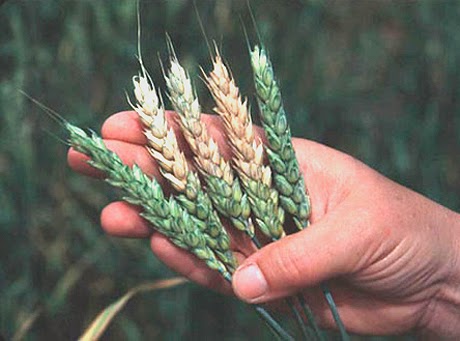A variety of wheat that is resistant to a destructive fungal disease has been found to have specialized and protective cell walls, according to research published in BMC Plant Biology. These insights could help to produce stronger, disease-resistant varieties of durum wheat for improved pasta production, Phys.org reports.
Fusarium Head Blight (FHB) is a fungal disease that affects
worldwide wheat production due to dramatic yield loss, and reduced grain
quality from toxins that make harvests unsuitable for consumption. While there
have been several studies looking at FHB disease resistance in common wheat,
little is known about durum wheat - one of the cereals most susceptible to
infection and the key ingredient in pasta and couscous. Italy is one of the
world's major producers of durum wheat, and FHB has been permanently present
there since 1995.
Lead author Daniela Bellincampi from Sapienza Università di
Roma, Italy, said: "Breeding disease-resistant varieties of durum wheat is
probably the best economic and ecological strategy for fighting this invasive
and destructive disease. Unfortunately, this is particularly challenging due to
a lack of highly disease-resistant varieties that are available to use in
breeding programs."
Joint author Agata Gadaleta from Università di Bari Aldo
Moro, Italy, said: "Now that we've identified the cell wall
characteristics that make a common wheat variety resistant to FHB, work can
begin on transferring these traits to vulnerable durum wheat varieties. These
could be cultivated in Italy and other countries to help produce safer food
with reduced fungal contamination and reduced amounts of dangerous toxins in
food stocks."
The researchers compared a disease-resistant variety of
common wheat and a susceptible variety of durum wheat. To do this, they
infected both with the fungus, and then compared the detailed characteristics
of their cell walls.
The cell walls of the FHB-resistant variety had a particular
composition of lignin - a structural component which plays a crucial role in
cell wall reinforcement - and showed unique compositions of other structural
components including pectin and hemicellulose.
The researchers identified a new gene, WheatPME1, that can
play a role in changing the chemical structure of pectin - the adhesive
component of the plant cell wall. They found that, during infection, the gene
had different levels of activity in the FHB-resistant and susceptible
varieties.
The researchers hope that the identification of these unique
cell wall traits in FHB-resistant common wheat could help in breeding durum
wheat varieties that are able to defend themselves against infection, and reduce
fungal toxin contamination in food.
First author Vincenzo Lionetti from Sapienza Università di
Roma, Italy, said: "Understanding the dynamics of plant cell wall
composition and structure during infection is important to reveal strategies
that plant and pathogen exploit to prevail during their interaction."
Read the article HERE.
The Global Miller
This blog is maintained by The Global Miller staff and is supported by the magazine GFMT
which is published by Perendale Publishers Limited.
For additional daily news from milling around the world: global-milling.com



No comments:
Post a Comment